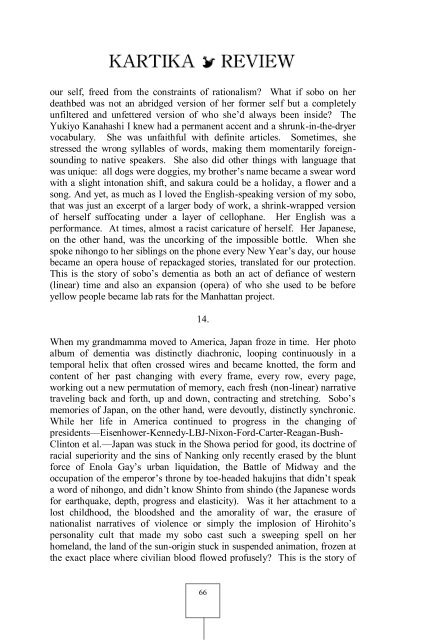Create successful ePaper yourself
Turn your PDF publications into a flip-book with our unique Google optimized e-Paper software.
our self, freed from the constraints of rationalism? What if sobo on her<br />
deathbed was not an abridged version of her former self but a completely<br />
unfiltered and unfettered version of who she’d always been inside? The<br />
Yukiyo Kanahashi I knew had a permanent accent and a shrunk-in-the-dryer<br />
vocabulary. She was unfaithful with definite articles. Sometimes, she<br />
stressed the wrong syllables of words, making them momentarily foreignsounding<br />
to native speakers. She also did other things with language that<br />
was unique: all dogs were doggies, my brother’s name became a swear word<br />
with a slight intonation shift, and sakura could be a holiday, a flower and a<br />
song. And yet, as much as I loved the English-speaking version of my sobo,<br />
that was just an excerpt of a larger body of work, a shrink-wrapped version<br />
of herself suffocating under a layer of cellophane. Her English was a<br />
performance. At times, almost a racist caricature of herself. Her Japanese,<br />
on the other hand, was the uncorking of the impossible bottle. When she<br />
spoke nihongo to her siblings on the phone every New Year’s day, our house<br />
became an opera house of repackaged stories, translated for our protection.<br />
This is the story of sobo’s dementia as both an act of defiance of western<br />
(linear) time and also an expansion (opera) of who she used to be before<br />
yellow people became lab rats for the Manhattan project.<br />
14.<br />
When my grandmamma moved to America, Japan froze in time. Her photo<br />
album of dementia was distinctly diachronic, looping continuously in a<br />
temporal helix that often crossed wires and became knotted, the form and<br />
content of her past changing with every frame, every row, every page,<br />
working out a new permutation of memory, each fresh (non-linear) narrative<br />
traveling back and forth, up and down, contracting and stretching. Sobo’s<br />
memories of Japan, on the other hand, were devoutly, distinctly synchronic.<br />
While her life in America continued to progress in the changing of<br />
presidents—Eisenhower-Kennedy-LBJ-Nixon-Ford-Carter-Reagan-Bush-<br />
Clinton et al.—Japan was stuck in the Showa period for good, its doctrine of<br />
racial superiority and the sins of Nanking only recently erased by the blunt<br />
force of Enola Gay’s urban liquidation, the Battle of Midway and the<br />
occupation of the emperor’s throne by toe-headed hakujins that didn’t speak<br />
a word of nihongo, and didn’t know Shinto from shindo (the Japanese words<br />
for earthquake, depth, progress and elasticity). Was it her attachment to a<br />
lost childhood, the bloodshed and the amorality of war, the erasure of<br />
nationalist narratives of violence or simply the implosion of Hirohito’s<br />
personality cult that made my sobo cast such a sweeping spell on her<br />
homeland, the land of the sun-origin stuck in suspended animation, frozen at<br />
the exact place where civilian blood flowed profusely? This is the story of<br />
66


